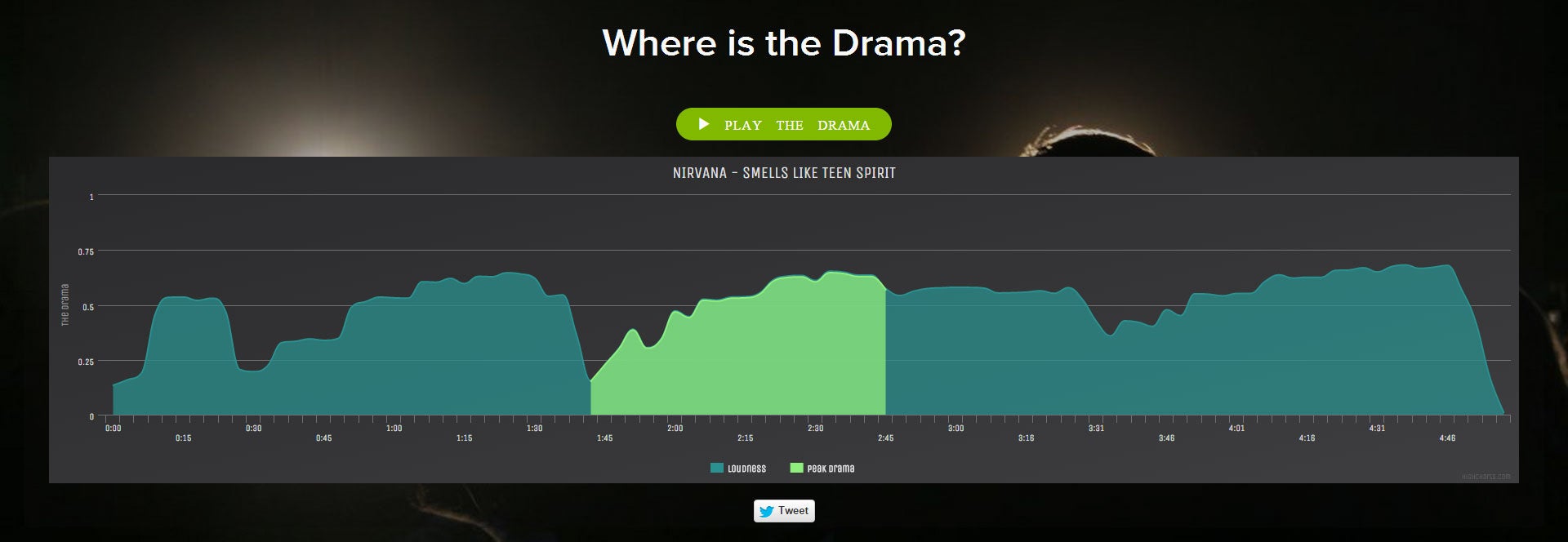Spotify releases new app for listeners who moan 'Don't bore us: get to the chorus'
You can now skip to the point where a song achieves 'peak loudness'

Nirvana understood the power of the "quiet verse, loud chorus" dynamic when they recorded "Smells Like Teen Spirit". But now impatient fans can dispense with a song's build-up and skip straight to the explosive crescendo with a new app released by Spotify.
The Where Is The Drama plug-in analyses audio data from the 20 million songs in the streaming service's database and identifies the segment where a song achieves "peak loudness" – the guitars are turned up to 11, drums are battered, the singer emits a piercing roar and the track achieves lift-off.
The web app was developed at a "hack day" by Paul Lamere, director of developer community for The Echo Nest, a music intelligence division within Spotify.
He wanted to test the theory that music's emotional power often lies with an effective change of dynamics within a song.
Indie band Pixies popularised the "soft- loud" dynamic with songs like "Gigantic" (a documentary about the band was even titled loudQUIETloud).
Kurt Cobain admitted he aped the band's "tension and release" formula for "Smells Like Teen Spirit". The structure remains widely used by festival headlining bands such as Biffy Clyro and Foo Fighters.
When fans search for their favourite song in the web-app, the audio analysis generates a "loudness curve" which directs them directly to the most dramatic portion of the song.

In Led Zeppelin's "Stairway to Heaven", listeners have to tolerate five minutes and 20 seconds of noodling before the drama occurs, the app finds. "Smells Like Teen Spirit" hits a "peak drama" score of 0.65 at two minutes and 33 seconds.
The curve demonstrates how songs in the dubstep genre, which incorporate a "drop", where the sound is peeled back before the track builds to a pumping crescendo, also effectively use "tension and release" dynamics.
But type in a contemporary chart-topper, such as "Blame" by Calvin Harris and the graph shows how the dynamics have been flattened for much current pop, with a compression effect in the production creating songs which start loud and remain at the same level.
Lamere said: "There's a whole range of music based on tension and release. Post-rock bands like Mogwai use dramatic builds to get to epic parts of songs which can be 10 minutes long. But what if you just want to find the best bits? Then you don't need to listen to the whole song."
Spotify's data could tell musicians which parts of a song people listen to repeatedly and also the point where they get bored and move on to the next song, Lamere suggested, which could influence the music they write.
But the tool might also create a more varied sonic palette for chart-pop. "People often just mix songs as loud as they can to grab the listener's attention," Lamere said. "The algorithm shows that music which has a diverse range of sounds and a wider use of dynamics sounds better."
The software developer cited dubstep producer Nero as an effective use of dynamics but he hopes the app will not add to decreasing attention spans. "Skipping straight to the dramatic bits is like a reader going to the final page of a mystery novel to find out who did it. The app is a bit of a novelty but people can see whether the computer agrees with you about where the best, most dramatic section of a song is."
Lamere's algorithm looks for the part of the song with the largest rise in volume over the course of a 30 second window. Extra weight is given to crescendos that culminate in louder dB peaks.
Join our commenting forum
Join thought-provoking conversations, follow other Independent readers and see their replies
Comments